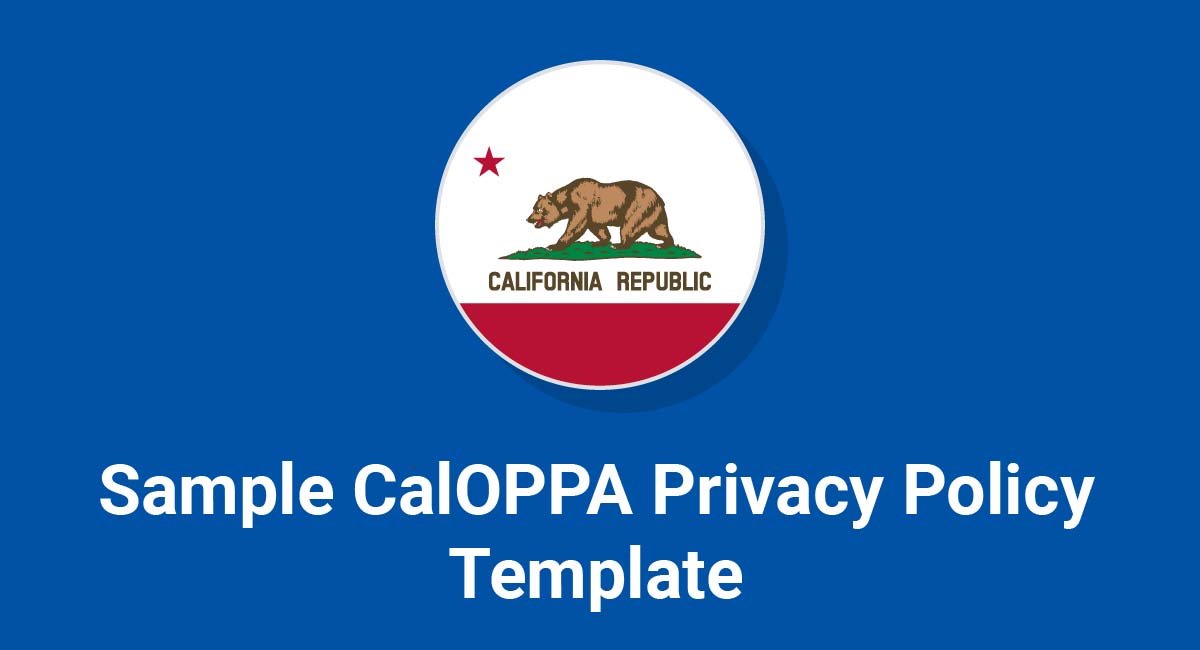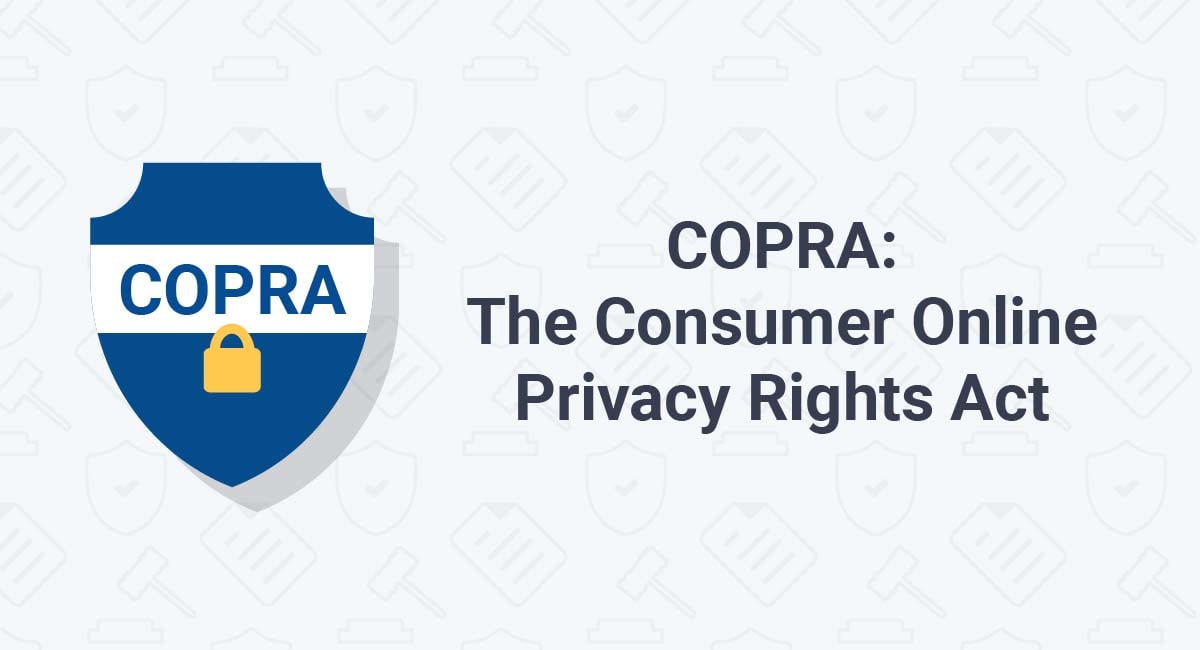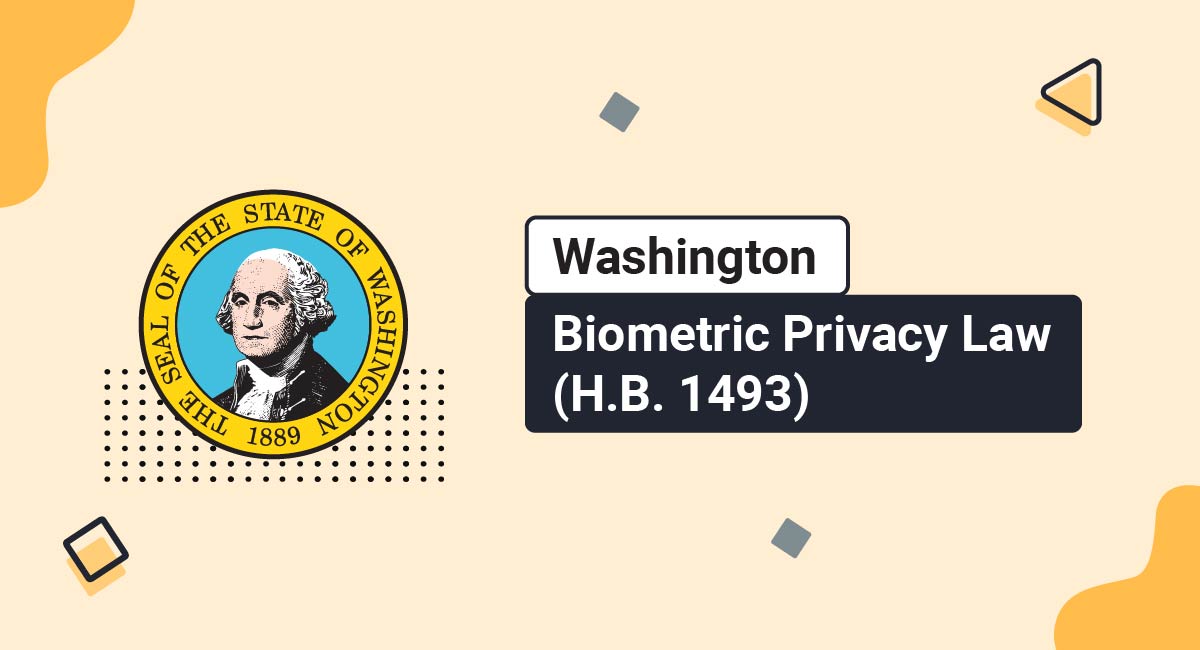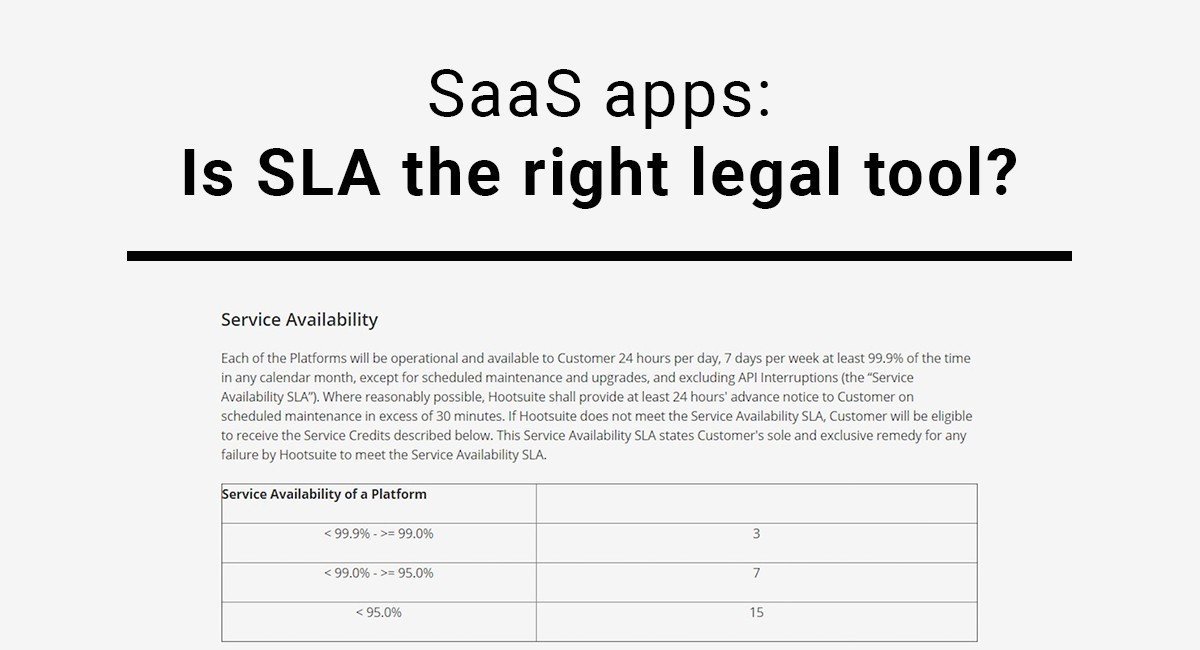Over 39 million people live in California. Do you think there's a possibility that one of them may find his way onto your website or mobile app? If so, your Privacy Policy will need to comply with the California Online Privacy Protection Act (CalOPPA).
In this article, we're going to walk you through how to create a CalOPPA Privacy Policy and examine the California law known as CalOPPA.
We've also put together a Sample CalOPPA Privacy Policy Template that you can use to help write your own.
Our Privacy Policy Generator makes it easy to create a Privacy Policy for your business. Just follow these steps:
-
At Step 1, select the Website option or App option or both.

-
Answer some questions about your website or app.

-
Answer some questions about your business.

-
Enter the email address where you'd like the Privacy Policy delivered and click "Generate."

You'll be able to instantly access and download your new Privacy Policy.
- 1. CalOPPA and Your Privacy Policy
- 1.1. What if Your Business is Not Located in California?
- 2. How to Comply With CalOPPA
- 2.1. 1. Post a Conspicuous and Public Privacy Policy
- 2.1.1. Conspicuous Privacy Policy for Websites
- 2.1.2. Conspicuous Privacy Policy for Mobile Apps
- 2.2. 2. Notify Users About the Information You Collect
- 2.3. 3. Notify Users About Third-Party Data Sharing
- 2.4. 4. Provide Users with Access to Review or Change Their Personal Information
- 2.5. 5. Let Users Know When You Make Changes to the Privacy Policy
- 2.6. 6. Post the Effective Date of Your Privacy Policy
- 2.7. 7. Explain How Your Business Responds to Do Not Track Signals
- 3. Examples of CalOPPA Privacy Policies
- 4. Download Sample CalOPPA Privacy Policy Template
- 4.1. Sample CalOPPA Privacy Policy Template (HTML Text Download)
- 4.2. Sample CalOPPA Privacy Policy Template (PDF Download)
- 4.3. Sample CalOPPA Privacy Policy Template (Word DOCX Download)
- 4.4. Sample CalOPPA Privacy Policy Template (Google Docs)
- 4.5. More Privacy Policy Templates
CalOPPA and Your Privacy Policy

If you've been managing an online business for any amount of time, you've probably already put together a Privacy Policy. If not, the time to establish a Privacy Policy is now! It is required by law in almost every developed nation.
A Privacy Policy is a statement that informs visitors and customers about the kinds of personal information you collect about them, how you use it, and how you share it with third parties.
CalOPPA is one of the laws that will almost certainly influence how you will write your Privacy Policy. In short, it's a California-enacted set of regulations that requires the following measures regarding consumer privacy:
- Post a public Privacy Policy on your mobile app or website and make it conspicuous and easy to find.
- Inform users exactly which types of personal information you collect about them.
- Inform users about who you share the information with.
- Provide users with an easy, accessible way to review and make changes to their personal information.
- Let users know when changes to Privacy Policy take place and how they will be informed of those changes.
- Post the effective date of the Privacy Policy.
- Explain how your business responds to Do Not Track signals from web browsers and provide a link to or a description on how to block tracking technology.
What if Your Business is Not Located in California?
Although it does apply to California-based businesses as well, CalOPPA pertains to any company that collects personal information from California residents regardless of where that company is located. Because of the global nature of the internet, this law not only applies to most any business in the United States, but it can also be (and has been) enforced in other countries as well.
According to CalOPPA, personal information is defined as any data that may be used to identify a person, such as:
- First and last name
- Physical address
- Email address
- Telephone number
- Social security number
- Any other identifier that may be combined with other information to allow for the contacting of an individual, such as an IP address or geolocation data
At the very least, your business will likely collect emails or IP addresses from visitors in order to provide your services. If one of those visitors is a California resident, then CalOPPA applies to you.
Here is a short rundown:
- For businesses based in California, compliance with CalOPPA is an absolute must.
- For businesses based in other states of the USA, it is highly likely that one or more of your current or future visitors will reside in California.
- For businesses based in the EU, unless you are blocking USA users from using your website, there is a possibility that a California resident will wander in one day.
In any of the above scenarios, compliance with CalOPPA is highly recommended. Failure to do so could result in a fine of $2,500 per user, per violation.
How to Comply With CalOPPA

While the measures required by CalOPPA do not diverge greatly from the common practices of Privacy Policies in general, there are a few items you'll want to double-check and/or change to ensure full compliance:
1. Post a Conspicuous and Public Privacy Policy
Conspicuous Privacy Policy for Websites
Most websites automatically include a link to the Privacy Policy within the footer navigation of each page. This is often referred to as a browsewrap agreement, meaning that visitors may find the Privacy Policy on any page if they choose to look for it. However, the browsewrap method may not be deemed conspicuous enough according to CalOPPA requirements:

As you can see in CalOPPA section 22577 above, the link must contain the word "privacy" and be distinguishable from the surrounding text by way of font, size, or color so that "a reasonable person would notice it."
These stipulations might not be met in the case of a small footer link. One solution could be larger, more obvious links throughout the website, but this may not be conducive to the design and flow of your layout.
Another popular solution is the clickwrap agreement. This refers to the practice of requiring users to agree to the Privacy Policy in order to register, login, or otherwise use your services.
Steam requires users to click to accept its Privacy Policy before signing up:
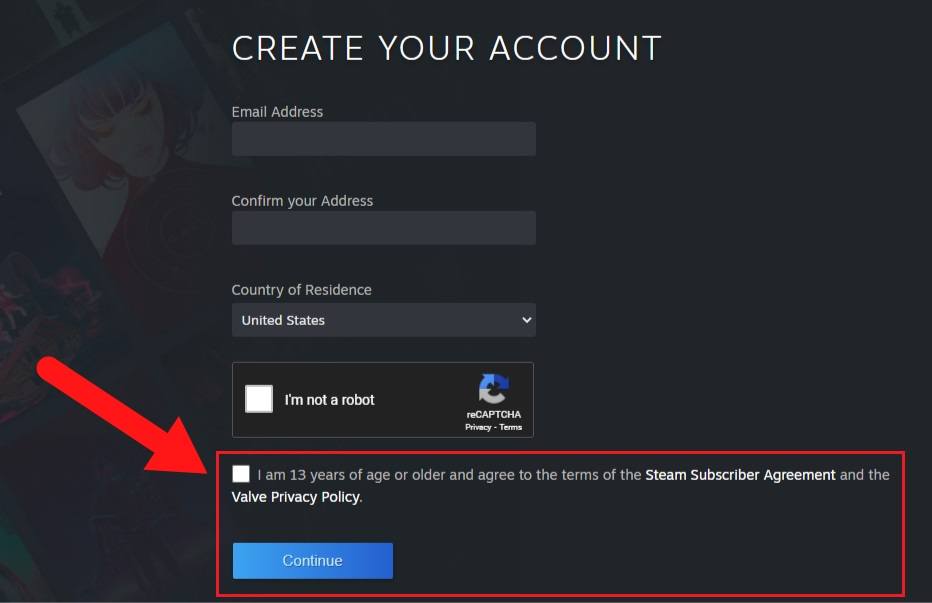
The clickwrap method is an effective way to ensure that your users are given ample opportunity to see and read the Privacy Policy before using your services, while also complying with CalOPPA requirements.
Conspicuous Privacy Policy for Mobile Apps
The same rules apply to mobile applications. A link to the Privacy Policy within the application settings interface is standard practice, but it is not considered compliant with CalOPPA's definition of conspicuous.
Cabify places a link to its Privacy Policy in the Help interface:
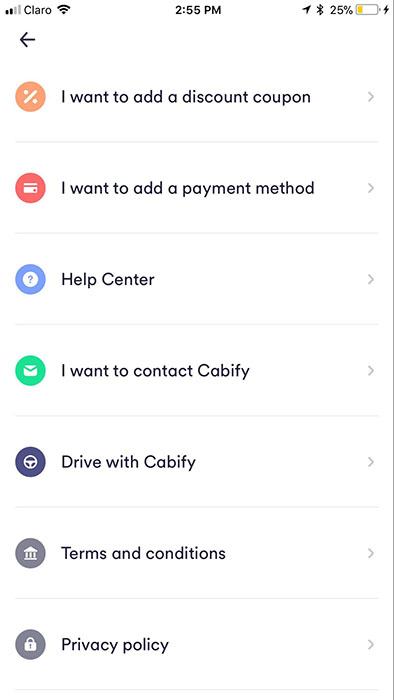
Along with the settings link, a clickwrap agreement is always recomended for mobile apps since there are less opportunities for prominent links throughout the basic interface.
Cabify also includes a link to its Privacy Policy in its registration interface:
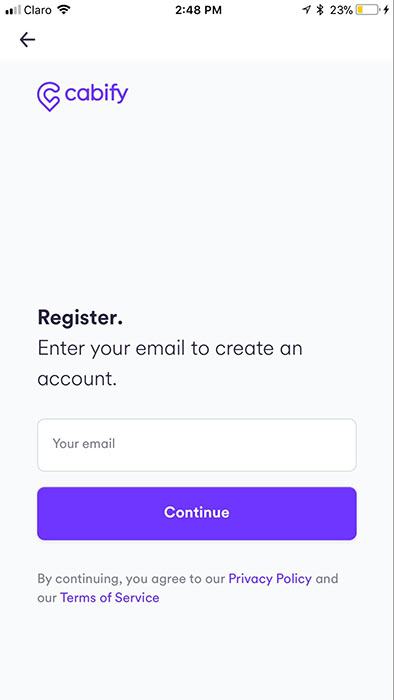
In this way you can confirm that as many users as possible are seeing and reading your Privacy Policy, satisfying CalOPPA requirements and limiting your own liability in case of future privacy disputes.
2. Notify Users About the Information You Collect
CalOPPA requires that any and all information you collect about consumers be listed within your Privacy Policy.
This includes both the information you collect directly from users, data that is collected automatically such as IP address or geolocation, and data you collect from third-party sources.
Microsoft's Privacy Policy includes an exhaustive list of the data collected from users. This is an excerpt of the entire clause:
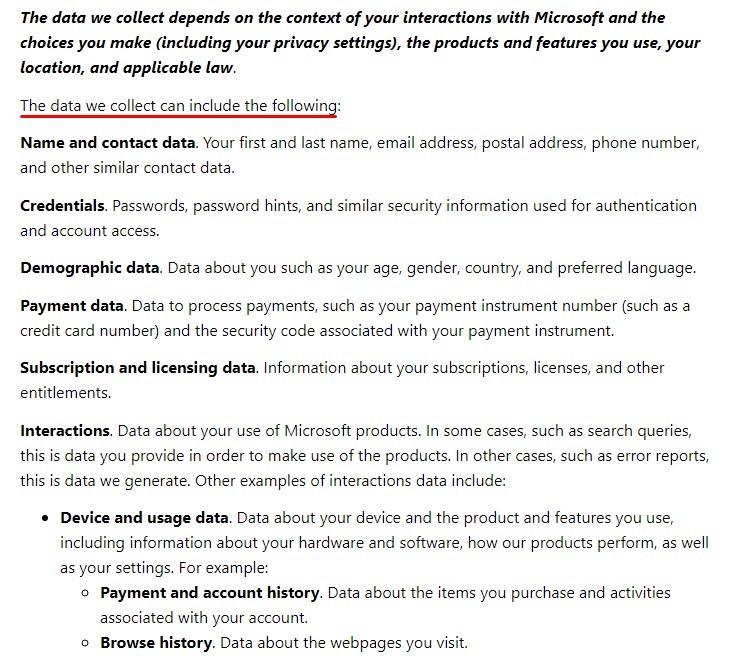
It's also highly recommended by the California Attorney General that you describe how information is collected, be it through direct web forms, cookies, or other methods.
Here, Microsoft goes on to explain the different methods used to collect information:
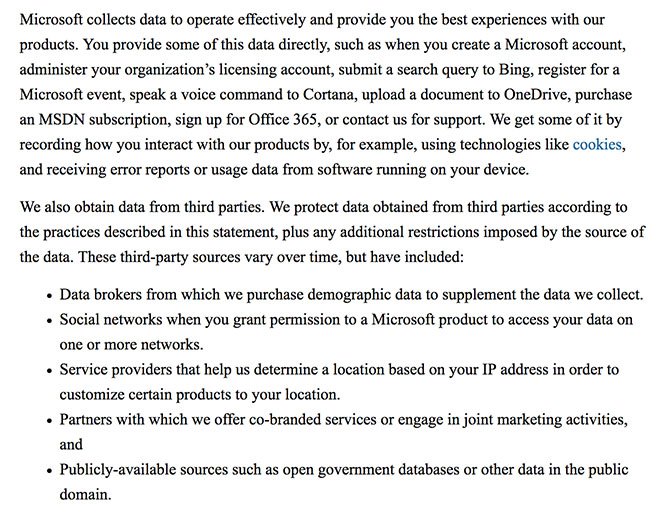
3. Notify Users About Third-Party Data Sharing
Whether it's for analytical purposes, transaction processing, or advertising, you must inform users of any third-parties you share consumer information with.
Amazon explains the ways in which it shares customer information and its reasons for doing so:
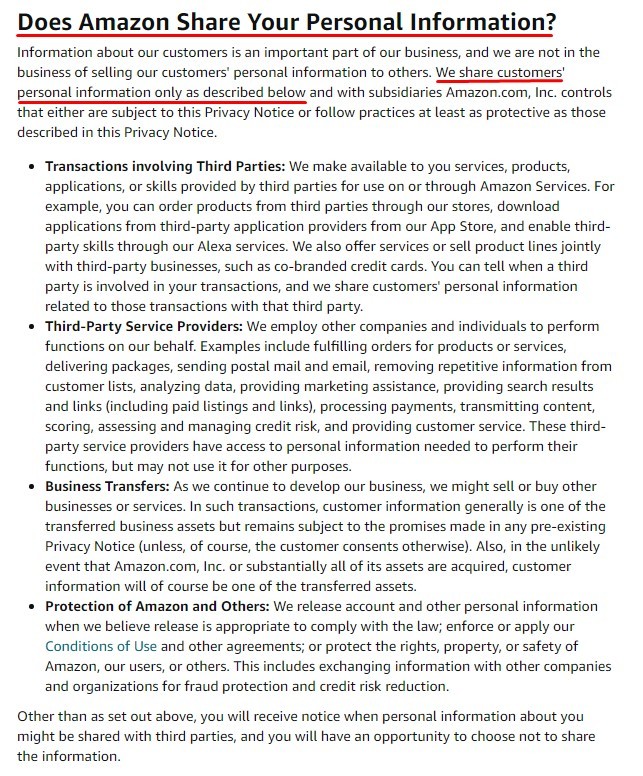
This includes any advertising or analytics services you work with.
In the case of targeted advertising, it is recommended that you include information about opting-out of those programs. Amazon goes so far as to provide a direct link for opting out of targeted advertising:
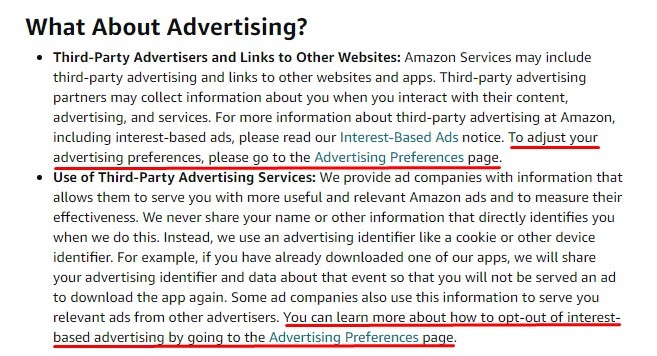
4. Provide Users with Access to Review or Change Their Personal Information
Describe the choices users have in regard to the collection, use, or sharing of their personal data. Let them know of any processes you have in place for customers to access and review their information, as well as how to make changes or delete information.
Lookout describes various ways for users to access and make changes to their personal information:
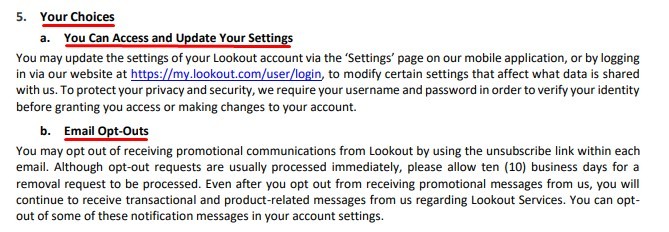
If it's not possible for users to access or make changes to their own information via an online portal, then you should let users know who to contact in order to review and make changes to the personal data you have on file.
5. Let Users Know When You Make Changes to the Privacy Policy
Most privacy laws around the world include this stipulation and CalOPPA is no different. Any changes to your Privacy Policy should be announced publicly at the time when or before the changes take place.
Also be sure to include a section in your Privacy Policy that lets users know about how they may be informed of those changes in the future.
Edison Tech explains its procedure for Privacy Policy revisions and communicating those changes:

6. Post the Effective Date of Your Privacy Policy
This is a bit self-explanatory, but just in case - always post the latest effective date of your Privacy Policy and renew the date every time the policy is updated.
Sony posts its effective date at the very top of the Privacy Policy page:

7. Explain How Your Business Responds to Do Not Track Signals
This may be the CalOPPA statute that has created the most confusion, but it's actually not overly complicated.
Here's a basic rundown of what it means:
- All web browsers are equipped with a method to send out a "Do Not Track" (DNT) signal to websites for users that do not wish to have tracking cookies or other tracking devices installed in their browsers. It is not required by law to adhere to the DNT signal, so many websites ignore them.
- CalOPPA requires that each business include a section in their Privacy Policy that states clearly how the business responds to DNT signals - whether the signals are accepted or ignored.
- If the company provides its own alternate solution to prevent user tracking, such as an interface to turn off tracking cookies, this solution must be described. If the business does not provide this feature, a link to instructions on how to turn on DNT signals in web browsers is recommended.
- If the business does ignore DNT signals and installs tracking software regardless, they must include a description of what information they are gathering in this method and why.
- Finally, don't forget to title the section clearly with a reference to "Do Not Track Signals" or "California Do Not Track Disclosure."
Apple provides a clear, easy-to-understand disclosure of its response to DNT signals and how to send DNT signals from Apple's Safari browser. Note that it also mentions third-party affiliates that may place tracking cookies:

Now that we've looked at what CaOPPA requires for your Privacy Policy, let's take a look at some real-life examples of CalOPPA compliance from exisiting businesses and their Privacy Policies.
Examples of CalOPPA Privacy Policies

Although most companies are making some attempt at complying with CalOPPA requirements, some are more exemplary than others. Here are a few excellent examples.
LinkedIn includes a link to its Privacy Policy within its account registration form so users can access it before sharing any personal information with the company:
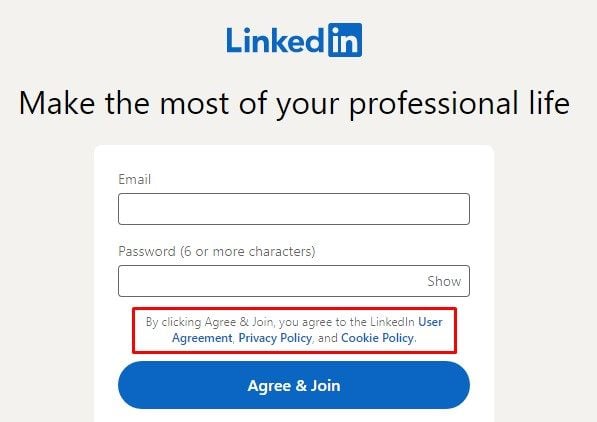
As you can see, the user must agree to the Privacy Policy in order to join LinkedIn.
Once the visitor clicks through, the effective date of the policy is posted right at the top, along with a statement that the Policy has been updatd:
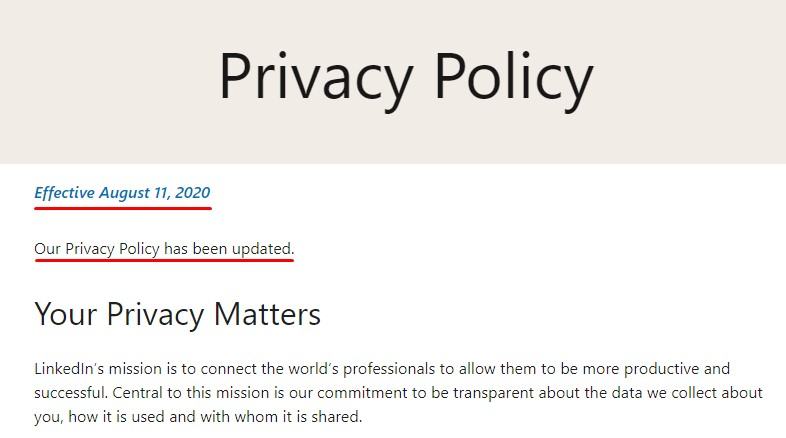
Next follows a section that addresses the variety of types of of personal information collected by LinkedIn. Here's only an excerpt:
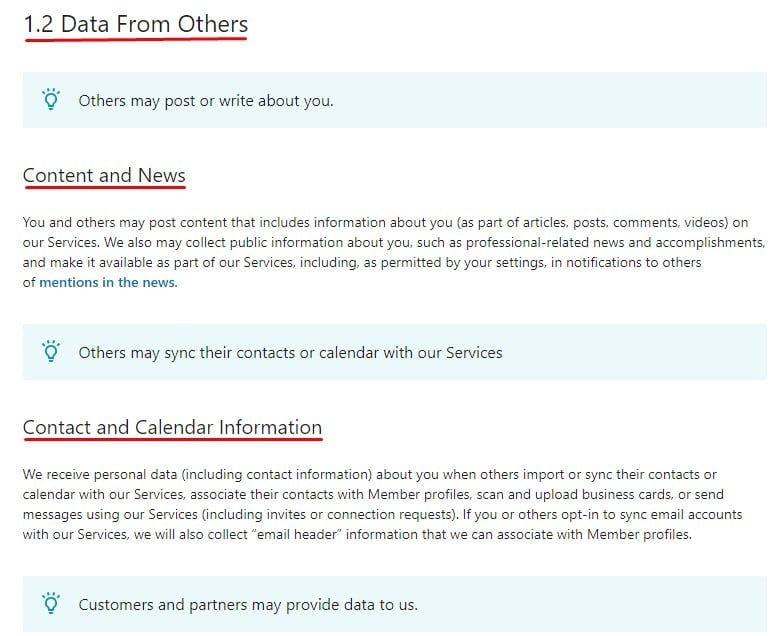
LinkedIn goes on to explain how and when and why it shares user data with third party advertisers:

Further down in the Policy, it provides a set of links and different ways for users to access or make changes to their information and how it is used:
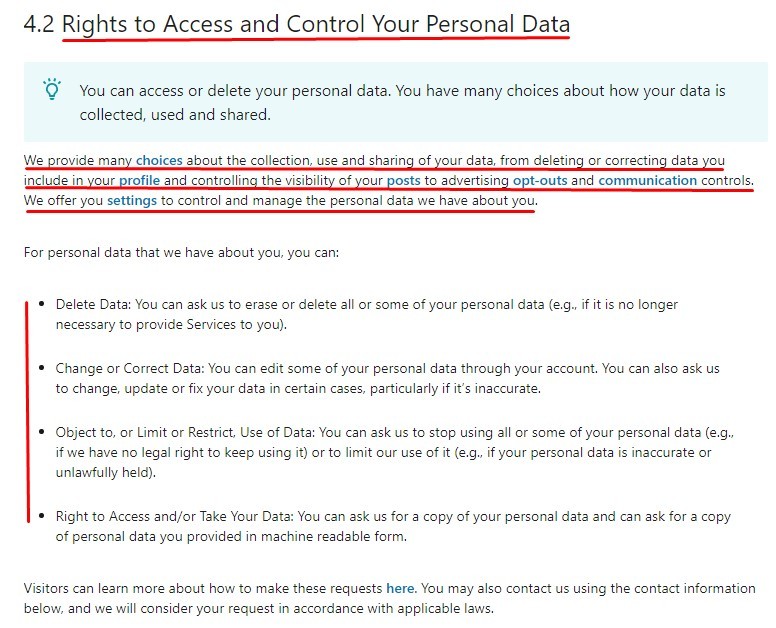
LinkedIn provides a short, to-the-point clause about its DNT practices along with a link to further information:

Finally, users are informed about how changes to the Privacy Policy may happen and that material updates will be communicated:
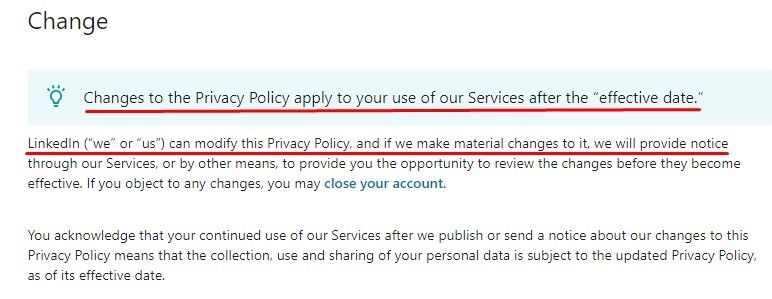
Overall, LinkedIn complies with CalOPPA very well.
Tribune is a publishing house that owns prominent newspapers like the Los Angeles Times.
Its Privacy Policy has a "last updated" and effective date at the very top:

The information collected is provided as a detailed list that goes on to include automatically collected information and third-party providers of personal information:
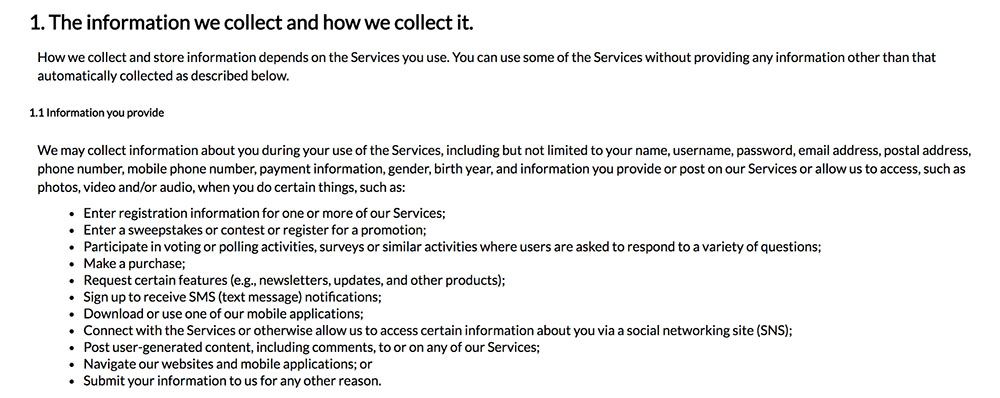
Tribune lays out a comprehensive list of how it shares personal data with third parties and why:
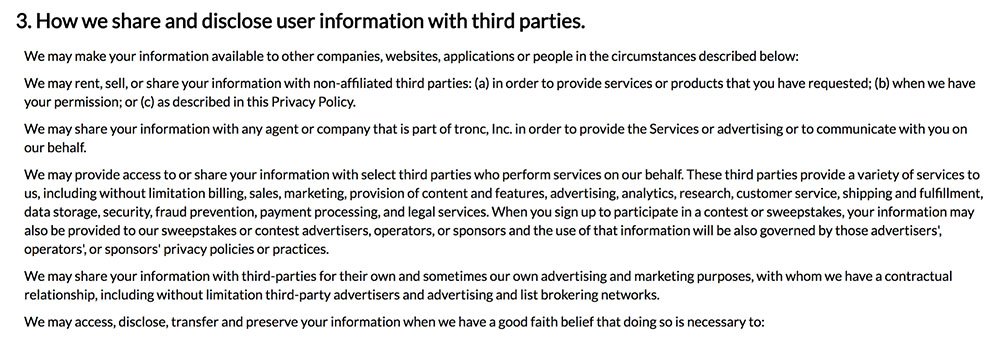
DNT requirements are met with this paragraph:

Tribune offers consumers two different methods for accessing or changing their personal data:

Finally, a "Changes to Policy" clause informs users that the Privacy Policy can be changed and updated periodically:

As you can see by the examples above, CalOPPA's requirements don't call for a great deal of modifications above or beyond the clauses that already exist in a standard Privacy Policy.
Most of the requirements are best practices for any business, and are easy to implement either in an existing or newly-created Privcay Policy.
Download Sample CalOPPA Privacy Policy Template
Generate a Privacy Policy in just a few minutes
Our Sample CalOPPA Privacy Policy is available for download, for free. The template includes these sections:
- Definitions
- Collecting and Using Personal Information
- Usage Data
- Use of Personal Information
- Transfer of Personal Information
- Disclosure of Personal Information
- Security of Personal Information
- "Do Not Track" Policy as Required by California Online Privacy Protection Act (CalOPPA)
- Links to Other Websites
- Changes to Privacy Policy
- Contact Information
Sample CalOPPA Privacy Policy Template (HTML Text Download)
You can download the Sample CalOPPA Privacy Policy Template as HTML code below. Copy it from the box field below (right-click > Select All and then Copy-paste) and then paste it on your website pages & app screens.
Sample CalOPPA Privacy Policy Template (PDF Download)
Download the Sample CalOPPA Privacy Policy Template as a PDF file
Sample CalOPPA Privacy Policy Template (Word DOCX Download)
Download the Sample CalOPPA Privacy Policy Template as a Word DOCX file
Sample CalOPPA Privacy Policy Template (Google Docs)
Download the Sample CalOPPA Privacy Policy Template as a Google Docs document
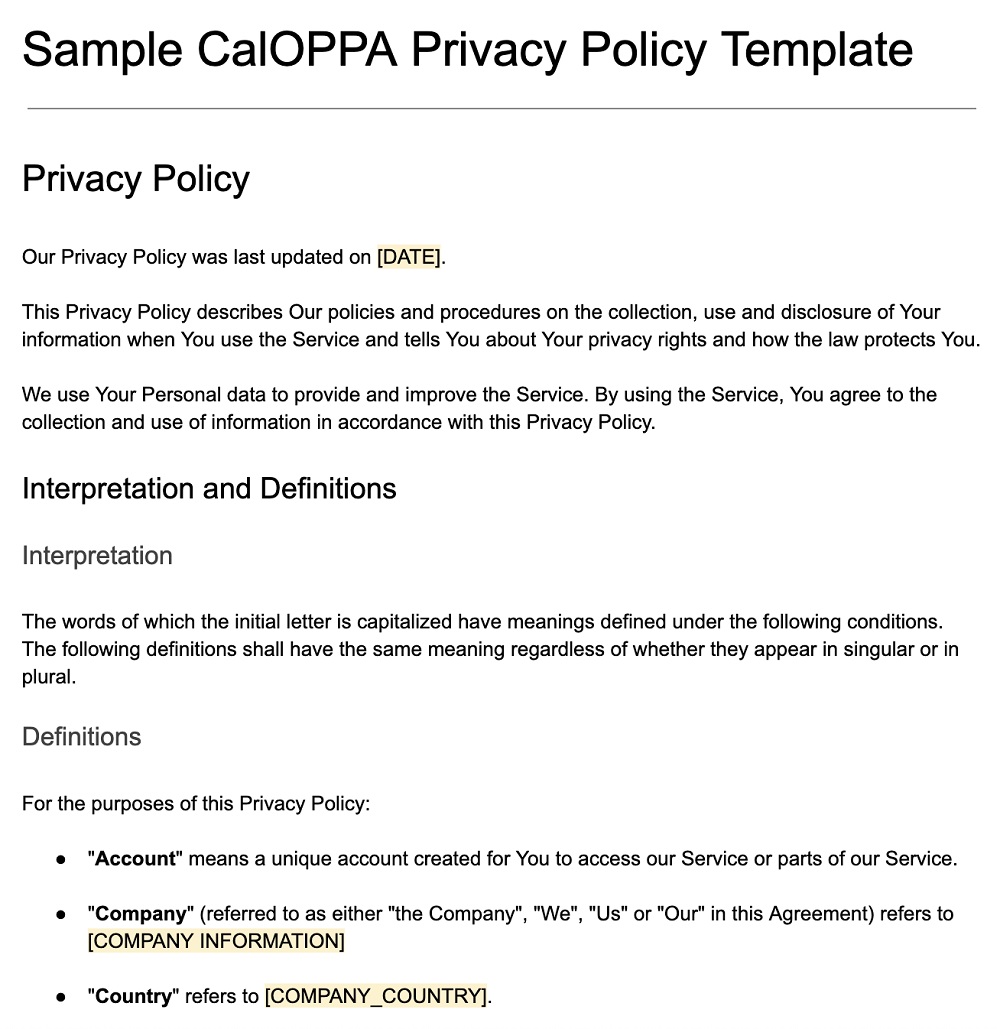
More Privacy Policy Templates
More specific Privacy Templates are available on our blog.
| Sample Privacy Policy Template | A Privacy Policy Template for all sorts of websites, apps and businesses. |
| Sample Mobile App Privacy Policy Template | A Privacy Policy Template for mobile apps on Apple App Store or Google Play Store. |
| Sample GDPR Privacy Policy Template | A Privacy Policy Template for businesses that need to comply with GDPR. |
| Sample CCPA Privacy Policy Template | A Privacy Policy Template for businesses that need to comply with CCPA. |
| Sample California Privacy Policy Template | A Privacy Policy Template for businesses that need to comply with California's privacy requirements (CalOPPA & CCPA). |
| Sample Virginia VCDPA Privacy Policy Template | A Privacy Policy Template for businesses that need to comply with Virginia's VCDPA. |
| Sample PIPEDA Privacy Policy Template | A Privacy Policy Template for businesses that need to comply with Canada's PIPEDA. |
| Sample Ecommerce Privacy Policy Template | A Privacy Policy Template for ecommerce businesses. |
| Small Business Privacy Policy Template | A Privacy Policy Template for small businesses. |
| Privacy Policy for Google Analytics (Sample) | A Privacy Policy Template for businesses that use Google Analytics. |
| Sample CalOPPA Privacy Policy Template | A Privacy Policy Template for businesses that need to comply with California's CalOPPA. |
| Sample SaaS Privacy Policy Template | A Privacy Policy Template for SaaS businesses. |
| Sample COPPA Privacy Policy Template | A Privacy Policy Template for businesses that need to comply with California's COPPA. |
| Sample CPRA Privacy Policy Template | A Privacy Policy Template for businesses that need to comply with California's CPRA. |
| Blog Privacy Policy Sample | A Privacy Policy Template for blogs. |
| Sample Email Marketing Privacy Policy Template | A Privacy Policy Template for businesses that use email marketing. |

Comprehensive compliance starts with a Privacy Policy.
Comply with the law with our agreements, policies, and consent banners. Everything is included.
